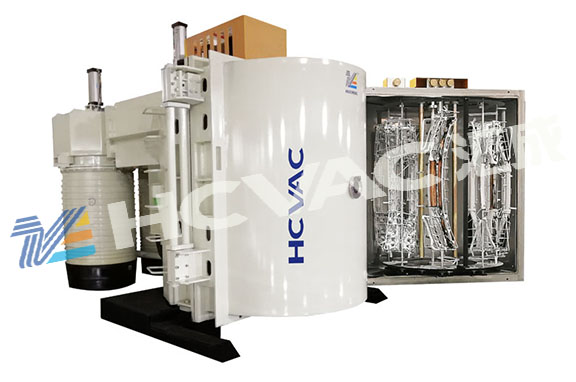When manufacturers purchase pvd coating machines, merchants will train the relevant knowledge of pvd coating machines, such as coating technology process steps, principles, maintenance methods, machine operation precautions, etc. Today, we will introduce PVD to everyone. Process steps and principles of vacuum coating machine coating technology.

The process steps of pvd coating machine coating technology are divided into the following four steps:
(1) Cleaning the workpiece: Turn on the DC power supply, and the argon gas performs glow discharge to form argon ions. The argon ions bombard the surface of the workpiece, and the particles and dirt on the surface of the workpiece are splashed and thrown out;
(2) Gasification of the plating material: that is, after the alternating current is applied, the plating material is evaporated and gasified.
(3) Migration of plating ions: atoms, molecules or ions supplied by the gasification source rush to the workpiece at high speed after collision and high-voltage electric field;
(4) Deposition of atoms, molecules or ions of the plating material on the substrate: When the evaporating material ions on the surface of the workpiece exceed the number of sputtered ions, they gradually accumulate to form a layer of plating that is firmly adhered to the surface of the workpiece.
If it is ion plating, the ionized particles of the evaporation material have kinetic energy of 3,000 to 5,000 electron volts. When bombarding the workpiece at high speed, not only the deposition rate is fast, but also it can penetrate the surface of the workpiece and form a deep diffusion layer implanted into the substrate. , the interface diffusion depth of ion plating can reach four to five microns, that is to say, it is dozens or even hundreds of times deeper than the diffusion depth of ordinary vacuum coatings, so they adhere to each other very strongly.
PVD (Physical Vapor Deposition) is physical vapor deposition, which is divided into: vacuum evaporation coating, vacuum sputtering coating and vacuum ion coating. What we usually call PVD coating refers to vacuum ion coating and vacuum sputtering; usually NCVM coating refers to vacuum evaporation coating. The coating process principle of PVD vacuum coating machine is divided into the following three situations:
(1) Basic principle of vacuum evaporation: Under vacuum conditions, metals, metal alloys, etc. are evaporated, and then deposited on the surface of the substrate. The method of evaporation is usually resistance heating, electron beam bombardment of the plating material, evaporation into a gas phase, and then deposited on the surface of the substrate. Substrate surface, historically, vacuum evaporation is the earliest technique used in PVD method.
(2) The basic principle of sputtering coating: Under the vacuum condition filled with argon (Ar) gas, the argon gas is subjected to glow discharge. At this time, the argon (Ar) atoms are ionized into argon ions (Ar), and the argon ions act on the electric field force. Under the accelerated bombardment, the cathode target made of plating material will be sputtered out and deposited on the surface of the workpiece. The incident ions in the sputtering coating are generally obtained by glow discharge, in the range of 10 -2 Pa ~ 10Pa, so the sputtered particles are easy to collide with the gas molecules in the vacuum chamber during the process of flying to the substrate, causing movement The orientation is random and the deposited film tends to be uniform.
(3) The basic principle of ion plating: Under vacuum conditions, a certain plasma ionization technology is used to partially ionize the atoms of the plating material into ions, and at the same time, many high-energy neutral atoms are generated, and a negative bias is applied to the substrate to be plated. In this way, under the action of a deep negative bias, ions are deposited on the surface of the substrate to form a thin film.
When many businesses purchase
pvd coating machines, it is essential to understand the process steps and principles of the machine, as well as maintenance and so on.



